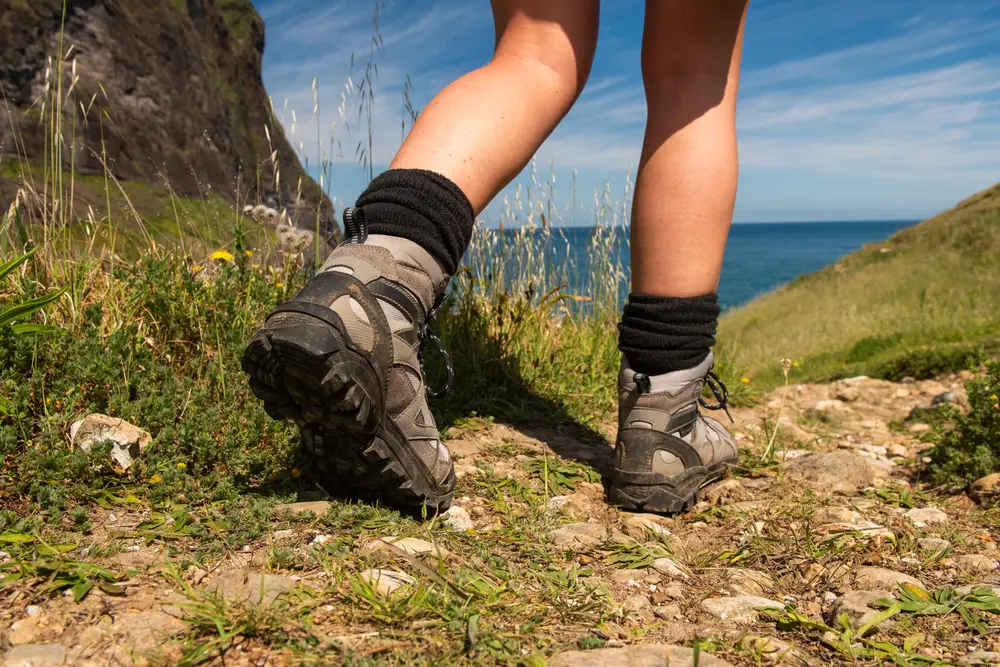Let's face it... footwear for hiking is not attractive. Hiking shoes and hiking boots are excellent for protecting your feet but are not designed for looks.
I agree that it is not much you can do about ugly boots. However, there are a few options out there that can protect your feet and look good.

In this article, we will cover the logic behind hiking shoe design and why it is more important than appearance.
Table of Contents
Why Can’t Hiking Shoes Be Fashionable And Protective?
When we go shopping for hiking boots, what are we looking for? We need ankle support. We need padding to prevent blisters.
We need tread on the bottom that will last and will also give us traction on rough terrain. We either need a waterproof shell to keep our toes dry, or we need ventilation to keep cool.
Rarely does appearance come at the top of this list of priorities? However, this one thing is still going to be a factor no matter what. When you get a pair of hiking boots, you want them to function and also look good.
Unfortunately, the problem is that the features we need to protect our feet on hiking trips dictate the appearance of the shoes. Hiking shoes are always going to have a high ankle and a boxy appearance to them. The sole is going to be thick with an aggressive tread to help with rugged terrain.
If you look around you will find that some manufacturers have managed to add the features needed for a rough terrain type in a way that is still attractive.
Hiking Shoes and Boots - Built for the Outdoors
So what is it about hiking boots that make them so ugly, and what can be done by manufacturers to make them more appealing? Some of the features that make hiking boots ideal for our needs cannot be manipulated much. For example, you cannot reduce the height of the ankle much without losing the ankle support needed to protect your ankles when hiking.
Instead of messing with the height of the ankle, some boots have changed the lace placement or the cut of the top edge of the boot to make them more pleasant looking. These design options are subtle, but they make a difference in the profile of your boots. The boots are still very much ready to take on the outdoors.
If you need your hiking boots to have vents for airflow, it will affect the way the boots appear. They will have a choppy appearance. However, some manufacturers are careful with the size, placement, and shape of the vents to make the boots more attractive.
If you want waterproof or water-resistant hiking boots, you will not have this problem. However, the layering of leather or other materials will drastically affect the appearance. I find that hiking shoes or boots with fewer seams are more water-resistant and are also more attractive.
Insulation is vital for cold weather hiking and often provides the padding needed to prevent blisters. However, that insulation can make your boots appear puffy and unnatural. If you are going to be wearing thick wool socks as I do, I suggest buying boots one size larger than you normally buy.
Not only will buying the boots a bit large cause them to maintain their normal shape, but it will also keep your feet warmer. Insulation of any kind works best when there is a thin layer of air between the insulation and your skin. This air is warmed by body heat and held in place by the insulation.
The rubber soles of your hiking boots are needed for your boots to be built for the wilderness. However, thick aggressive treads are often ugly. If you check around, you will find hiking boots that have an aggressive tread but have attractively attached to the sole.
Finally, laces make a difference. It may be the last thing you think about, but it is one thing you can change. Thick, round laces are going to be stronger and more functional for hiking. They are also more attractive than flat, cheap laces. You can stick with the factory laces, or you can always swap them out for something better.
Are There any Hiking Boots that Aren’t Ugly?
Believe it or not, there are boots out there that are attractive and protect people when they hit the trail. I was planning a 41-mile hike last year and needed hiking shoes that would handle the rocky ground on the path. These trails were known for being rugged, and hikes were strenuous.
I started my search for hiking boots. I needed them to have a high ankle, waterproofing, and an aggressive tread. Most that I saw had things with which I was not comfortable. For example, they would have a solid design but reviews showed they were not durable. Some were functional, but I didn't like their appearance.
I ended up looking at a higher price point than I expected, but it was the only way to find good-looking boots with every feature I wanted. I landed on a Free Soldier Tactical model. These boots are tough, they are waterproof, they have lots of ankle support, and they give me ideal traction. They are a good example of the balance I mentioned.
Fashion vs Outdoor Clothing - What's the Difference?
Have you ever considered the differences in priorities for fashion-based clothing versus outdoor clothing? The people designing these types of hiking gear have completely different motives.
Fashion designers are focused on appearance over every other feature. They will pick non-durable materials over durable materials if they can make the product more attractive. The design often ignores functionality hoping to get some sales strictly on looks.
Outdoor clothing designers typically put functionality over some other priorities. This means that features like the high ankle, vents, waterproofing, or an aggressive tread are primarily in place to make the hiking boots easier on the feet of the men and women that wear them. The look of the hiking gear takes a back seat.
Every once in a while you can find a manufacturer that has mastered the balance between good looks and functionality. When we look at other gear, you can see many clear examples.
Every year I shop for hiking pants that are waterproof, attractive, and functional. I found a pair this year that checked all of the boxes. The pants stretched for being active, they had lots of pockets in the right places, they were lightweight, and they were attractive.
Everyone can find boots with this balance if they look hard enough. It all comes down to the placement, shape, size, and material type for each of the needed features to make hiking boots that can handle the trail.
Conclusion
As you can see, finding a pair of hiking shoes that are attractive and can handle your hiking trip can be tough. It is just the nature of the gear. Boot design has to focus on the features that keep men and women hiking.
The function is the top priority for people. This is how most outdoor gear is designed. However, many footwear manufacturers pay more attention to the placement and appearance of these features. Often these are the people that provide the advantage of the highest overall quality for their product as well.
Take the time to look around, and you will find boots that fit your needs and look great.
- Are Merrell Shoes Good? – An Unbiased Review of Merrell Footwear - December 9, 2023
- Where Are Merrell Shoes Made? - December 9, 2023
- Camping in 40-degree Weather: Tips and Tricks - September 25, 2023

![Why Do Hiking Boots Have Red Laces? [5 Reasons Why] Why Do Hiking Boots Have Red Laces? [5 Reasons Why]](https://grandcircletrails.com/wp-content/uploads/2022/07/Why-Do-Hiking-Boots-Have-Red-Laces-150x150.jpg)
![Why is My Air Mattress Deflating but No Holes? [5 Possible Reasons] Why is My Air Mattress Deflating but No Holes? [5 Possible Reasons]](https://grandcircletrails.com/wp-content/uploads/2021/09/Why-is-My-Air-Mattress-Deflating-but-No-Holes-1-150x150.jpg)
![Do Columbia Shoes Run Big or Small? [Here is the Answer] Do Columbia Shoes Run Big or Small? [Here is the Answer]](https://grandcircletrails.com/wp-content/uploads/2022/04/Do-Columbia-Shoes-Run-Big-or-Small-1-150x150.jpg)

![How Long Will Ice Last in a Yeti Cooler? [Read Here] How Long Will Ice Last in a Yeti Cooler? [Read Here]](https://grandcircletrails.com/wp-content/uploads/2022/02/How-Long-Will-Ice-Last-in-a-Yeti-Cooler-1-150x150.jpg)
![Do Columbia Jackets Shrink? [Here Is The Answer] Do Columbia Jackets Shrink? [Here Is The Answer]](https://grandcircletrails.com/wp-content/uploads/2022/05/Do-Columbia-Jackets-Shrink-150x150.jpg)